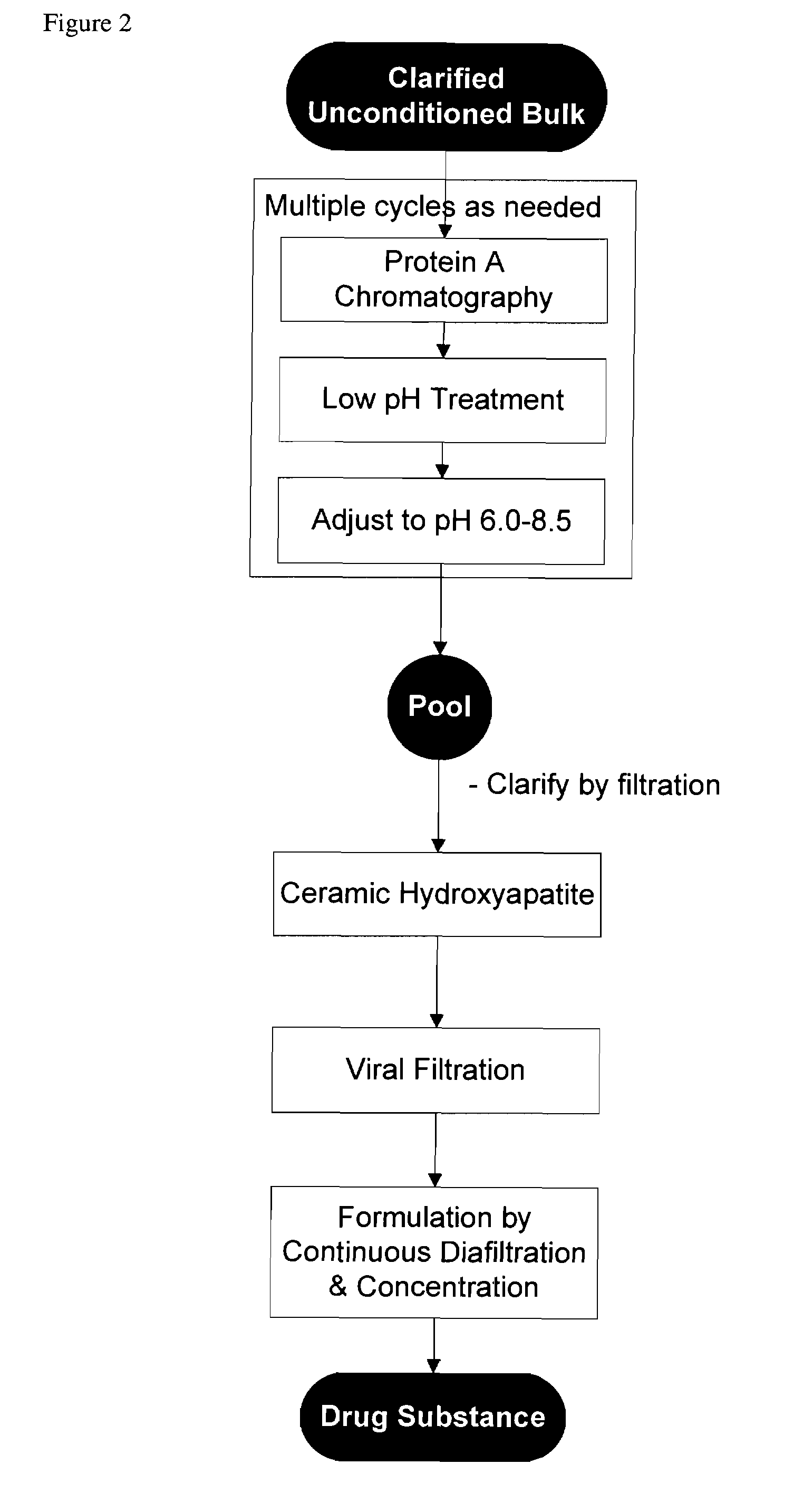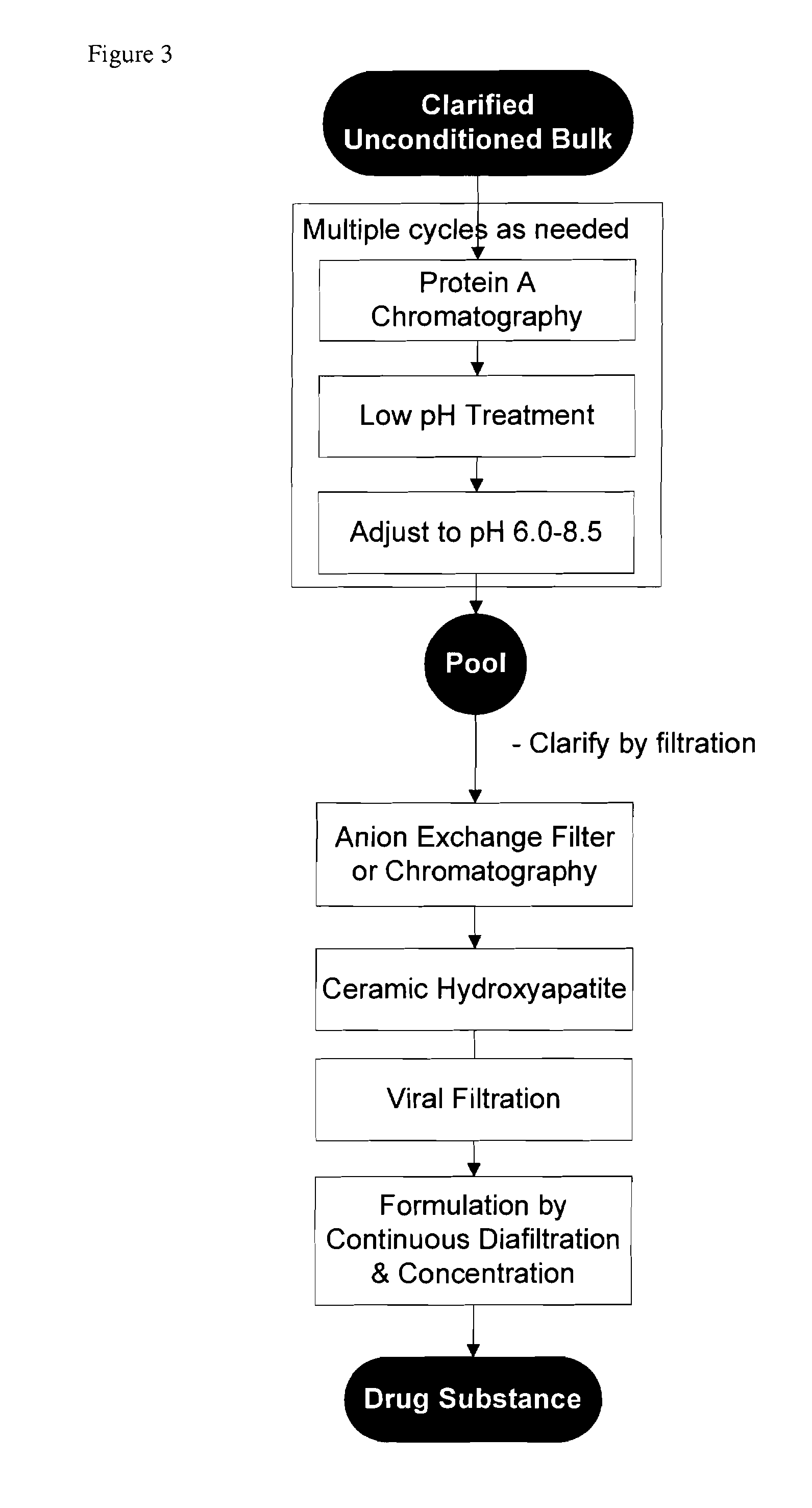Methods for purifying antibodies using ceramic hydroxyapatite
a technology of ceramic hydroxyapatite and purification method, which is applied in the field of purification of antibodies, can solve the problems of high cost, high cost, and difficulty in separation of residual protein a, and achieve the effect of increasing yield
- Summary
- Abstract
- Description
- Claims
- Application Information
AI Technical Summary
Benefits of technology
Problems solved by technology
Method used
Image
Examples
example 1
Purification of Monoclonal Antibody (an IgG1, anti-IL-5 Antibody) which Includes Sequential Protein a to Ceramic Hydroxyapatite Chromatography
[0084]In one embodiment, the process involves antibody purification by use of Protein A affinity, a preparative pH adjustment, and cHA chromatography. This process is depicted in FIG. 1.
[0085]By using cHA as described herein, only two chromatography steps are required, reducing the cost of manufacturing without compromising or diminishing the quality, purity or suitability of the monoclonal antibodies used for human administration.
[0086]Details of the individual process steps are described below. For each step, a brief description is given including the expected outcome. Important process parameters for each step are listed. All procedural details, buffer compositions, process set-points, column dimensions, etc. are included for illustrative purposes and should not be considered inclusive or restrictive in the operation of this art.
1.1 Affinit...
example 2
Includes sequential Protein A to Ceramic Hydroxyapatite to Viral Filter and Final Formulation by Ultrafiltration / Diafiltration
[0096]In one embodiment, the process involves antibody purification by use of Protein A affinity, a low pH adjustment for viral inactivation, an additional preparative pH adjustment, cHA chromatography, and final formulation by ultrafiltration / diafiltration. This process is depicted in FIG. 2.
[0097]By using cHA as described herein, only two chromatography steps are required, reducing the cost of manufacturing without compromising or diminishing the quality, purity or suitability of the monoclonal antibodies used for human administration.
[0098]Details of the individual process steps are described below. For each step, a brief description is given including the expected outcome. Important process parameters for each step are listed. All procedural details, buffer compositions, process set-points, column dimensions, etc. are included for illustrative purposes an...
example 3
Includes Sequential Protein A to Anion Exchange to Ceramic Hydroxyapatite to Viral Filter and Final Formulation by Ultrafiltration / Diafiltration
[0109]In another embodiment, the process involves monoclonal antibody purification by use of Protein A affinity, a low pH adjustment for viral inactivation, an additional preparative pH adjustment, anion exchange filtration (or chromatography), cHA chromatography, and final formulation by ultrafiltration / diafiltration. This process is depicted in FIG. 3.
[0110]An anion exchange filter (or column chromatography) is added as an example if additional clearance of DNA is need to give further assurance of product safety or quality.
[0111]Details of the individual process steps are described below. For each step, a brief description is given including the expected outcome. Important process parameters for each step are listed. All procedural details, buffer compositions, process set-points, column dimensions, etc. are included for illustrative purpo...
PUM
| Property | Measurement | Unit |
|---|---|---|
| Length | aaaaa | aaaaa |
| Molar density | aaaaa | aaaaa |
| Molar density | aaaaa | aaaaa |
Abstract
Description
Claims
Application Information
 Login to View More
Login to View More - R&D
- Intellectual Property
- Life Sciences
- Materials
- Tech Scout
- Unparalleled Data Quality
- Higher Quality Content
- 60% Fewer Hallucinations
Browse by: Latest US Patents, China's latest patents, Technical Efficacy Thesaurus, Application Domain, Technology Topic, Popular Technical Reports.
© 2025 PatSnap. All rights reserved.Legal|Privacy policy|Modern Slavery Act Transparency Statement|Sitemap|About US| Contact US: help@patsnap.com



